Transforming SAP with AI: A Deep Dive into Development, Data, Integration and Automation Tools
Transforming SAP with AI: A Deep Dive into Development, Data, Integration and Automation Tools.
Introduction
In today's fast-evolving digital landscape, businesses require innovative solutions to drive efficiency, enable seamless integration, and support data-driven decision-making. SAP, a global leader in enterprise software, offers a suite of transformative tools designed to address these needs. From low-code application development with SAP Build Apps to pro-code empowerment with SAP Build Code, and from unified business intelligence in SAP Analytics Cloud to intelligent data management with SAP HANA Cloud and SAP Datasphere, SAP’s technologies are reshaping how enterprises operate. Additionally, the SAP Integration Suite ensures seamless connectivity across systems, while SAP Business Process Automation streamlines workflows to enhance productivity. This series of articles explores these groundbreaking SAP platforms, highlighting their potential to empower businesses and foster innovation.
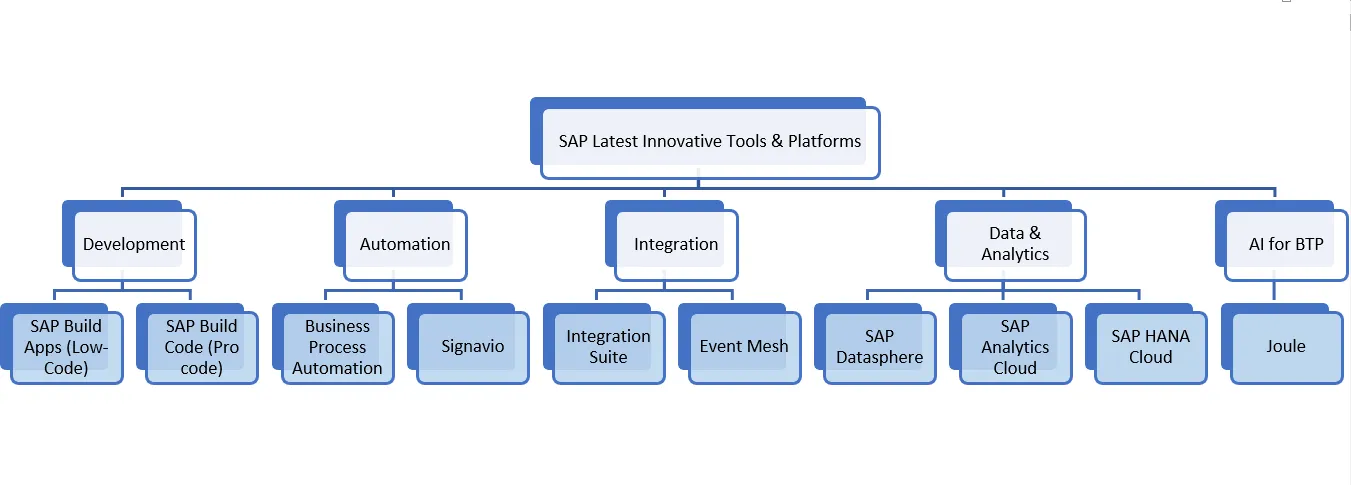
SAP Build Apps: Revolutionizing Application Development
1. Empowering Application Development with Low-Code Tools
SAP Build Apps is a low-code development platform that allows users to create both web and mobile applications with minimal effort. Its intuitive drag-and-drop interface enables developers and business users to build applications efficiently without requiring extensive coding expertise.
2. Comprehensive Backend Capabilities
SAP Build Apps includes robust backend capabilities, ensuring that applications are not only visually appealing but also functionally rich. Developers can connect apps to a no-code backend with a single click, integrate modern APIs in minutes, and access data from SAP systems or the cloud through SAP Business Technology Platform (SAP BTP) Authentication and Destinations.
3. Seamless Deployment to Cloud Foundry
Once an application is created using SAP Build Apps' graphical editor, it can be deployed effortlessly to Cloud Foundry. This feature ensures scalability and seamless integration into enterprise environments, empowering businesses to modernize their application infrastructure.
4. Business Users as Citizen Developers
SAP Build Apps allows business users to confidently design and deploy enterprise-grade applications that work seamlessly across all operating systems—all without writing a single line of code. This democratization of application development empowers non-technical users to drive digital innovation within their organizations.
5. Boosting Developer Productivity
For professional developers, SAP Build Apps significantly reduces coding efforts when creating complex data models and business logic. By automating repetitive tasks and streamlining development processes, it enhances productivity and accelerates application delivery.
6. Rapid API Integration and Data Connectivity
SAP Build Apps enables quick integration of APIs, allowing users to incorporate advanced functionalities into their applications with ease. Developers can consume data from SAP systems, cloud services, or other external sources, ensuring seamless connectivity and robust application performance.
7. Accelerated Learning with Built-In Onboarding Tools
SAP Build Apps offers an in-app learning experience designed to accelerate the onboarding process for new users. With guided tutorials and interactive lessons, users can quickly familiarize themselves with the platform and start building applications in no time.
Overall, SAP Build Apps bridges the gap between business users and professional developers, fostering collaboration and innovation. By simplifying application development with its low-code capabilities, seamless deployment options, and powerful backend integrations, SAP Build Apps enables organizations to create high-quality, scalable applications that align with their business needs.
________________________________________
SAP Build Code: Empowering Pro-Code Development
1. Pro-Code Development for Enterprise Applications
SAP Build Code is a professional-grade development tool designed for creating sophisticated applications. It supports the development of SAP Fiori and full-stack applications, offering a robust platform for SAP-centric programming.
2. AI-Powered Development with Joule Copilot
SAP Build Code leverages AI capabilities, particularly Joule Copilot, to revolutionize the coding process:
• AI-Driven Code Generation: Developers can use natural language descriptions to generate code and application logic automatically, adhering to SAP-centric programming models.
• Automated Data Modeling: Joule Copilot facilitates the creation of data models and sample data tailored to application requirements.
• Rapid Unit Testing: AI-generated unit tests enhance the quality and precision of existing code, ensuring high reliability.
3. Generative AI for CAP-Based Full-Stack Applications
The tool enables the near-automatic creation of full-stack applications using the SAP Cloud Application Programming (CAP) Model, powered by Generative AI. These applications can be seamlessly deployed on Cloud Foundry, ensuring scalability and flexibility.
4. Collaborative Development with Joule Copilot
Joule Copilot enhances developer productivity by enabling seamless collaboration and automation:
• Developers can request, update, and refine sample data dynamically.
• Application logic, such as record creation or function execution, can be generated effortlessly during development.
5. Tailored for SAP-Centric Development
SAP Build Code is designed specifically for SAP environments, utilizing prebuilt integrations, APIs, and business services from the SAP Service Center. It supports rapid extension of SAP S/4HANA and other SAP and non-SAP systems.
6. Comprehensive Development Ecosystem
SAP Build Code integrates multiple tools and frameworks into a unified developer environment:
• SAP Business Application Studio: A comprehensive IDE for coding and testing.
• SAP Cloud Application Programming Model (CAP): For full-stack development.
• SAPUI5 and SAP Fiori Elements: To create user-friendly interfaces.
• SAP Mobile Services: For extending applications to mobile platforms.
7. Application Lifecycle Management and Integrations
SAP Build Code provides a turnkey developer environment that simplifies coding, testing, integrations, and managing the entire application lifecycle. This ensures efficient development and faster time-to-market for enterprise applications.
Overall, SAP Build Code empowers developers with advanced AI tools, enabling efficient and high-quality application development tailored to SAP ecosystems. By automating complex tasks, supporting CAP-based full-stack applications, and integrating seamlessly with SAP services, it provides a comprehensive platform for professional developers to build, test, and deploy enterprise-grade applications at scale.
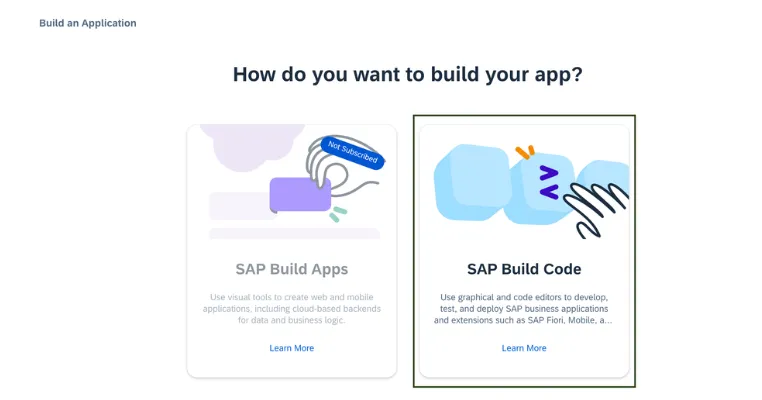
________________________________________
SAP Analytics Cloud: Transforming Business Intelligence and Decision-Making
1. Overview of SAP Analytics Cloud
SAP Analytics Cloud (SAC) is a comprehensive cloud-based solution offered as Software as a Service (SaaS) that combines business intelligence (BI), planning, and predictive analytics. It is designed to help organizations unlock the full potential of their investments in mission-critical business applications and valuable data sources.
2. Built on SAP Business Technology Platform
Natively built on the SAP Business Technology Platform (SAP BTP), SAC provides a unified, secure, and scalable public cloud environment. This platform empowers businesses to make data-driven decisions by seamlessly integrating analytics, planning, and predictive capabilities into their workflows.
3. Enhanced Analytical Applications and Ad-Hoc Analyses
• Analytical Applications: Analytics designers can create customized analytic applications for advanced data analysis and planning directly in SAC.
• Ad-Hoc Analyses: Users can leverage the data analyzer, a ready-to-run service, to perform multidimensional, pivot-style ad-hoc analyses. This feature supports SAP BW Live queries, SAP HANA Live views, SAP Datasphere models, and SAC models, providing unmatched flexibility for on-the-fly decision-making.
4. Connectivity with Diverse Data Sources
SAP Analytics Cloud connects seamlessly with both on-premise and cloud data sources, ensuring flexibility and efficiency:
• Supported Data Sources: SAP HANA, SAP S/4HANA, SAP BW/4HANA, SAP BusinessObjects, SAP Business Planning and Consolidation, SQL, OData, Google BigQuery, and more.
• Live Access: Users can access live analytics and insights from SAP Datasphere and SAP business applications like SAP S/4HANA without the need for data replication.
5. Accelerated Analytics with Prebuilt Business Content
SAP Analytics Cloud includes over 100 prebuilt best-practice business content packages designed for specific industries and business functions. These packages accelerate analytics and planning projects, helping organizations achieve faster results with less effort.
6. Integration with Microsoft Excel
SAC allows users to access live data models directly in Microsoft Excel. This integration enables further analysis using the familiar tools and functionalities of Excel, combining the power of SAP Analytics Cloud with Excel’s flexibility.
7. Generative AI for Enhanced Analytics
Generative AI capabilities in SAP Analytics Cloud enhance analytics and planning processes by enabling:
• Automated Reporting: Streamline the generation of detailed, accurate reports.
• Hidden Insights: Discover insights that may otherwise remain unnoticed in complex datasets.
• Joule Copilot: Create and develop business plans using this AI-powered tool for automation and intelligence.
• Natural Language Queries: The "Just Ask" feature (launched in Q1 2024) allows users to ask questions using natural language, regardless of their expertise, and receive instant, trusted insights into business data.
8. Advanced AI-Driven Functionalities
With its generative AI capabilities, SAC can build on business context and integrate quality data from SAP and non-SAP applications. This facilitates:
• Extending existing functionalities.
• Automating workflows for efficiency.
• Accelerating the delivery of business value with intelligent recommendations and insights.
9. Real-Time and Scalable Decision-Making
SAP Analytics Cloud provides businesses with real-time access to insights, scalable planning capabilities, and the ability to adapt analytics as business needs evolve. It supports organizations in achieving higher agility, better resource allocation, and smarter decision-making.
SAP Analytics Cloud’s comprehensive functionalities, seamless integrations, and cutting-edge AI capabilities position it as a cornerstone for modern enterprise analytics, enabling businesses to stay ahead in a competitive landscape.
________________________________________
SAP HANA Cloud: The Future of Intelligent Data Applications
1. Overview of SAP HANA Cloud
SAP HANA Cloud is a next-generation, multi-model database management system designed to empower developers and architects to create and deploy intelligent, data-driven applications at scale. Serving as a unified database, it supports both transactional (OLTP) and analytical (OLAP) workloads, offering unmatched flexibility for various use cases, including advanced application development and multi-model data processing.
2. Database-as-a-Service for Modern Applications
As a Database-as-a-Service (DBaaS), SAP HANA Cloud enables organizations to modernize their applications with features such as:
• Faster access to data for decision-making.
• Consumption-based pricing for cost efficiency.
• Elastic scalability to accommodate dynamic business needs.
• A fully managed environment to reduce administrative overhead and improve operational efficiency.
3. Simplified Development and Enhanced Productivity
SAP HANA Cloud minimizes routine maintenance tasks, allowing developers to focus on building innovative applications. With built-in security, compliance, and high availability, developers can rely on a robust foundation to create scalable and high-performing solutions.
4. Cloud Integration for Enhanced Storage and Processing
SAP HANA Cloud seamlessly integrates with on-premises SAP HANA environments, offering:
• Extended Storage: Offloading data to the cloud to expand on-premises storage while ensuring continuous accessibility for end users.
• Boosted Computing Capacity: Optimizing workloads by offloading data processing tasks to the cloud, ensuring efficient resource utilization for existing SAP HANA deployments.
5. Empowering AI-Driven Applications
With SAP HANA Cloud, developers can leverage advanced AI capabilities to create context-aware, intelligent applications. Key features include:
• Integration of generative AI to securely connect to business-critical data.
• Use of the vector engine to add business context to generative AI use cases.
• Automated selection of machine learning algorithms for accurate predictions.
• Integration of large language models (LLMs) with retrieval systems to deliver highly contextual and actionable insights.
6. Multi-Model and Versatile Data Management
SAP HANA Cloud supports a wide variety of data types, including relational, geospatial, graph, JSON, and vectors. Its multimodel capabilities allow developers to:
• Unify structured, semi-structured, and unstructured data, including text and multimedia, into a single application.
• Build adaptive applications that evolve as business processes change.
7. Addressing Data Challenges with Advanced Features
Equipped with fast in-memory storage, a multi-model engine, and flexible multi-tiering, SAP HANA Cloud efficiently handles:
• Growing data volumes.
• Diverse data types.
• Integration across multiple data sources.
Its real-time data access and native connectivity empower developers to build applications that enhance user expertise and business performance.
8. Transforming Businesses with Intelligent Applications
SAP HANA Cloud facilitates the creation of AI-powered applications that drive business transformation by:
• Enhancing operational efficiency with improved forecasting and decision-making.
• Enabling dynamic scenario planning and adaptive processes.
• Supporting scalable innovation that positions businesses for long-term success.
By offering a comprehensive platform for intelligent data applications, SAP HANA Cloud solidifies its role as a cornerstone of modern enterprise innovation.
Overall, with fast in-memory storage, a multi-model engine, and flexible multi-tiering capabilities, SAP HANA Cloud addresses the challenges of growing data volumes, varied data types, and integration across diverse data sources. Providing live access to real-time data and native connectivity to various sources, SAP HANA Cloud empowers your developers to create AI-based applications at scale that augment user expertise and improve business performance.
________________________________________
SAP Datasphere: Enabling Seamless Data Integration and Management
1. Unified Data Management for SAP and Non-SAP Data
SAP Datasphere is a comprehensive platform that supports:
• Data Integration: Streamlining data from diverse sources.
• Cataloging: Organizing metadata and data assets for easy accessibility.
• Semantic Modeling: Enhancing data understanding with contextual definitions.
• Data Warehousing: Centralizing data for analytics and reporting.
• Data Virtualization: Accessing data in real-time without duplication.
It harmonizes heterogeneous data, creating a unified environment for managing and utilizing business-critical information across your organization.
2. Next-Generation Data Warehousing
As the successor to SAP Data Warehouse Cloud, SAP Datasphere builds on its foundation while introducing enhanced capabilities:
• Simplified access to SAP and non-SAP data.
• Embedded SAP HANA Cloud features, including multi-model capabilities and built-in machine learning.
3. AI-Driven Automation with Joule
SAP Datasphere integrates Joule, an AI-powered assistant that automates tasks such as:
• Asset Creation: Developing reports, dashboards, and planning models using conversational commands.
• Data Interaction: Summarizing data and creating professional visualizations with natural language input.
Joule empowers users to interact with data more efficiently, reducing manual effort and enabling data-driven decision-making.
4. Key Capabilities of SAP Datasphere
a) Access Authoritative Data
• Directly access critical data and metadata, including relationships, from SAP applications.
• Solve complex requirements for semantic modeling using the SAP Datasphere Analytic Model.
• Reuse semantic definitions and associations from SAP applications for consistent data understanding.
b) Enrichment of Data Projects
• Combine and harmonize data using federation or replication capabilities.
• Leverage the data marketplace to enrich projects with trusted industry data from thousands of providers.
• Seamlessly integrate SAP and non-SAP data with tailored solutions from open data ecosystem partners.
c) Simplify Data Landscapes
• Access data across cloud and hybrid environments, ensuring flexibility.
• Organize and manage data for different business lines with Spaces in SAP Datasphere.
• Reuse up to 70-80% of existing SAP BW artifacts using the BW Bridge, streamlining the migration process.
5. Empowering Data Experts and Business Users
SAP Datasphere provides a central platform for data experts to:
• Distribute business-critical data while maintaining its context and logic.
• Create actionable insights and semantic models to meet business requirements.
Business users benefit from a simplified and user-friendly interface to access and analyze data products.
Overall, SAP Datasphere is a transformative tool for organizations seeking to unlock the full potential of their data landscape. By integrating AI-driven automation, multi-source data harmonization, and seamless SAP application integration, it empowers businesses to achieve data-driven innovation while simplifying complex data ecosystems.
________________________________________
SAP Integration Suite: A Comprehensive Integration Platform
1. Overview of SAP Integration Suite
SAP Integration Suite is a leading Integration Platform as a Service (iPaaS) that enables organizations to seamlessly connect and integrate their applications, data, and processes both within and beyond the enterprise. It simplifies integration through robust tools and services, enhancing efficiency and scalability.
2. Accelerating Integration with Key Features
SAP Integration Suite accelerates the development of integration scenarios through the following:
• Prebuilt Integrations: Ready-to-use solutions for rapid deployment.
• Connectors: Seamless connectivity to SAP and non-SAP applications.
• APIs and Data Graphs: Secure and scalable access to digital assets.
• Business Events: Event-driven integration to support asynchronous communication.
• Partner Integration Artifacts: Utilize contributions from partners for extended capabilities.
• AI-Assisted Integrations: Leverage artificial intelligence to simplify integration design.
• Automated Migrations: Transition effortlessly from PI/PO to Cloud Integration.
Additionally, the SAP Business Accelerator Hub offers an extensive repository of 3400+ prebuilt integrations, 3800+ APIs, 600+ business events, and 250+ connectors to further enhance integration efforts.
3. Core Capabilities of SAP Integration Suite
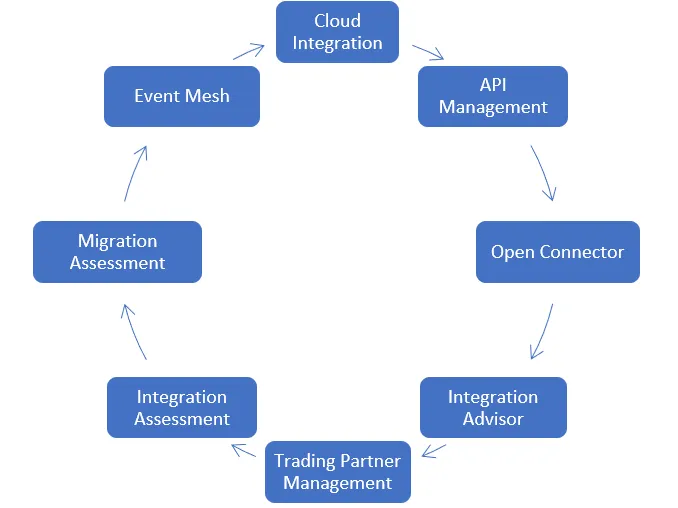
a) Cloud Integration
Integrate SAP and non-SAP systems across cloud and on-premise environments. It supports real-time message processing and spans diverse organizational boundaries.
b) API Management and Graphs
• Access and manage digital assets through secure APIs.
• Create semantically connected data graphs accessible via a unified API for streamlined data consumption.
c) Open Connectors
Build seamless integrations with over 160 non-SAP applications using prebuilt connectors to expand your integration landscape.
d) Integration Advisor
Accelerate the creation of business-oriented interfaces and mappings. Generate runtime artifacts quickly and reduce development efforts significantly.
e) Trading Partner Management
Simplify B2B communication by managing relationships with multiple trading partners through an intuitive interface designed for efficient collaboration.
f) Integration Assessment
Evaluate your organization's integration landscape using the Integration Solution Advisor Methodology (ISA-M). It provides recommendations on the best integration technologies for your specific requirements.
g) Migration Assessment
Assess existing integration scenarios to facilitate seamless migration to SAP Integration Suite.
h) Event Mesh
Enable event-driven integration by allowing systems to communicate asynchronously through SAP Event Mesh, ensuring efficient and scalable interaction.
4. SAP Business Accelerator Hub
The SAP Business Accelerator Hub acts as a central repository for digital content packages, including APIs, prebuilt integrations, business process models, and sample applications. It supports integrations with SAP applications such as SAP S/4HANA, SAP SuccessFactors, SAP Fieldglass, and SAP Customer Experience, as well as third-party solutions.
5. Generative AI for Integration Flow Creation
SAP Integration Suite introduces Generative AI (GenAI) capabilities within its Cloud Integration feature to streamline integration flow creation:
• Integration developers provide a description of the scenario.
• GenAI generates an integration flow based on the input, significantly reducing development time and effort.
This feature empowers developers to quickly design, test, and deploy integrations while maintaining high-quality standards.
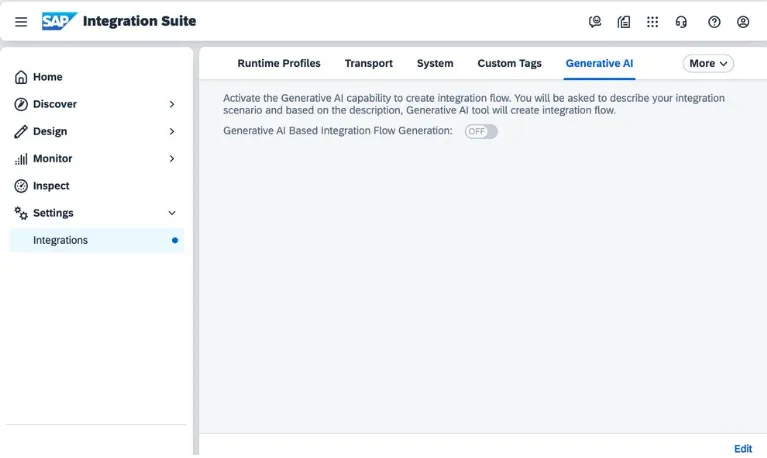
Overall, SAP Integration Suite stands as a robust and versatile platform, equipping organizations with the tools needed to seamlessly integrate diverse systems and processes. With advanced features like AI-assisted integrations, event-driven communication, and prebuilt content repositories, it accelerates digital transformation and fosters operational efficiency across industries.
________________________________________
SAP Business Process Automation: Streamlining Enterprise Workflows
1. Introduction
SAP Build Process Automation (SAP BPA) is a no-code solution designed for citizen developers to align, optimize, and innovate business processes. Leveraging workflow management and robotic process automation (RPA) functions, it empowers business developers, Line of Business (LoB) experts, and end-users to collaborate seamlessly. Business developers can design rules and workflows, create forms, approvals, and automations, while business users execute tasks through the SAP Task Center.
2. A Unified Platform
Available as a service on SAP Business Technology Platform (SAP BTP), SAP BPA provides a single interface to build, execute, automate, and monitor business processes using low-code/no-code capabilities. This approach simplifies process management and enhances efficiency across business functions.
2.1. Automating Business Processes
SAP BPA enables the automation of end-to-end business processes, focusing on optimizing workflows, reducing manual steps, and accelerating decision-making. Key features include:
o Process Design: Create workflows using a graphical interface with elements such as forms, authorizations, and automations.
o Trigger Types: Initiate processes with event triggers, automation triggers, scheduled triggers, or API triggers.
o Process Monitoring: Use built-in tools to oversee process performance and ensure optimal execution.
2.2. Task Automation with SAP BPA
In addition to end-to-end process automation, SAP BPA focuses on automating specific, repetitive tasks to save time and reduce errors. Key highlights include:
o Automate recurring tasks such as data entry, document reading, and routine activities.
o Employ virtual bots to perform manual, time-consuming tasks efficiently, freeing up resources for higher-value activities.
3. Embedded GenAI Capabilities
SAP Business process automation embeds Generative AI capabilities:
• Artifact generation and editing from natural language description
• Business summarization of complex artifacts providing objective and detailed steps
4. Enhancing Business Efficiency
With SAP Build Process Automation, organizations can reduce operational complexity, improve accuracy, and streamline workflows. The platform offers robust capabilities to transform both individual tasks and holistic business processes, driving innovation and productivity across the enterprise.
________________________________________
SAP Signavio: Empowering Business Process Transformation
1. Overview of SAP Signavio
SAP Signavio offers a comprehensive suite of tools to model, analyze, and optimize business processes, helping organizations increase operational efficiency and agility. With the Process Transformation Suite, businesses can document, understand, and continuously improve their processes to drive scalability and innovation.
2. Key Components of SAP Signavio
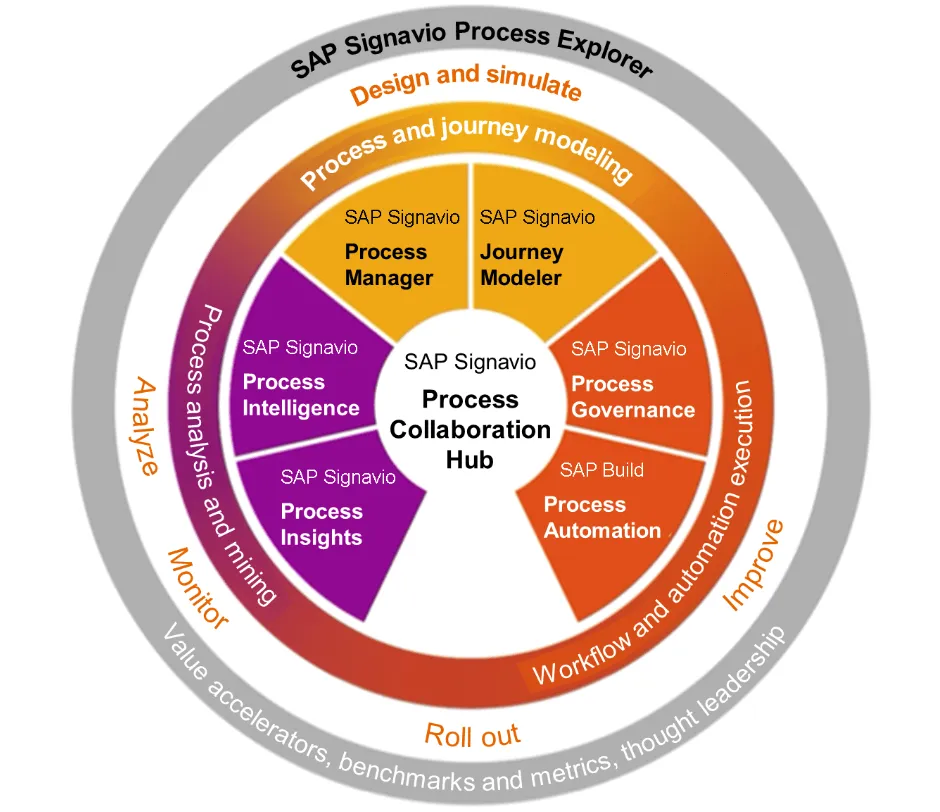
a. SAP Signavio Process Insights
• Provides continuous monitoring and customization of business processes.
• Collects performance data from SAP ERP systems (SAP ECC or SAP S/4HANA).
• Identifies weaknesses, optimization potential, and automation opportunities.
• Delivers actionable recommendations for scalable performance improvements.
b. SAP Signavio Process Intelligence
• Enables end-to-end process mining for operational excellence.
• Offers insights into actual process execution with root cause analysis and monitoring.
• Provides advanced process modeling and visualization to uncover inefficiencies and improvement areas.
• Facilitates faster insights for improving performance and efficiency.
c. SAP Signavio Process Manager
• A user-friendly platform for business process management (BPM).
• Supports process modeling, digital transformation, compliance, and training.
• Helps unify and maintain process models, reducing risks and ensuring consistent decision-making.
d. SAP Signavio Journey Modeler
• Integrates journeys, processes, metrics, and roles to align operational and experiential insights.
• Features 12 journey elements, including roles, touchpoints, sentiment, external data, and IT systems.
• Enhances the ability to understand and transform journeys in the context of business processes.
e. SAP Signavio Process Governance
• Helps organizations manage the lifecycle of processes, risks, and compliance requirements.
• Includes a configurable workflow builder with BPMN (Business Process Model and Notation) capabilities.
• Enables tracking and managing tasks directly without reliance on spreadsheets
f. SAP Signavio Process Collaboration Hub
• Acts as a centralized knowledge platform for all business processes.
• Provides real-time insights and fosters transparency across the organization.
• Serves as a focal point for uniting employee activities and expertise, ensuring a shared understanding of processes.
3. Transforming Business Processes with SAP Signavio
SAP Signavio empowers businesses to achieve process excellence by offering intuitive tools for process monitoring, modeling, and optimization. From ensuring compliance to improving customer and employee journeys, SAP Signavio facilitates end-to-end process transformation, enabling organizations to stay competitive in an ever-evolving business environment.
4. AI-assisted capabilities
SAP Business AI in SAP Signavio offers advanced capabilities like AI-generated process model recommendations based on expert knowledge from large language models and best practices. Premium AI functionalities, including the process recommender and performance indicators recommender, require SAP AI units and an active SAP Signavio Process Manager license. Furthermore, the AI-assisted process analyzer enables conversational insights, reducing time-to-insight by up to 50%. With the November release of the SAP Signavio Process Transformation Suite, Joule has been integrated into the SAP Signavio Process Collaboration Hub, offering early adopters in Germany and the U.S. navigational, informational, and transactional use cases, such as process discovery and dashboard creation guidance
________________________________________
Artificial Intelligence for SAP BTP: Empowering Businesses with SAP AI
SAP's vision for AI is to integrate it seamlessly into all products and business processes across SaaS and PaaS domains for its customers. This goal is realized through three core components: Joule, Embedded AI Capabilities, and the AI Foundation on SAP BTP. Joule serves as a generative AI copilot embedded within SAP applications, providing advanced functionalities like natural language processing and generative AI. Embedded AI Capabilities enhance SAP solutions by automating tasks and enabling intelligent data analysis. Meanwhile, the AI Foundation offers customers a unified and streamlined approach to leveraging AI functionalities on SAP BTP.

SAP Joule: Revolutionizing Business Processes with Generative AI
Overview of Joule
Joule is a generative AI-powered copilot integrated into SAP solutions for streamlining key business processes in HR, finance, supply chain, purchasing, and sales. Launched in September 2023 on the SAP Business Technology Platform, Joule uses natural language input to deliver precise answers, enhance decision-making, and learn from existing data while upholding robust data privacy standards.
Key Usage Patterns of Joule
1. Navigational Pattern:
Joule enables users to discover and access relevant applications by describing their tasks in natural language. It identifies suitable apps based on the user's intent, allowing them to select and open applications seamlessly, enhancing productivity and user experience.
2. Transactional Pattern:
This pattern allows users to perform tasks directly through Joule’s conversational interface without navigating to separate apps. Users can execute actions such as creating sales orders, updating procurement data, or accessing financial documents, simplifying business processes.
3. Informational Pattern:
Joule provides quick access to organizational information and policies, eliminating the need for assistance from HR or other departments. Users can retrieve relevant documents, such as HR policies, by interacting with Joule conversationally.
4. Analytical Pattern:
Joule empowers users with actionable insights by compiling data from various sources. It allows the creation of custom reports on demand within the interface, eliminating the need for prebuilt templates and enabling real-time, data-driven decision-making.
Embedded AI
SAP Business AI includes a suite of artificial intelligence (AI) capabilities embedded within SAP business processes, designed to help organizations achieve real-world results with responsible data usage. These capabilities are built into various SAP solutions, including finance, supply chain, procurement, sales, marketing, human resources, and IT.
SAP AI Foundation
Overview of SAP AI Foundation
The SAP AI Foundation on SAP Business Technology Platform (BTP) provides a comprehensive suite of AI capabilities and services to enhance SAP applications and customer solutions. As the core enabler of SAP’s embedded AI capabilities, it supports businesses in automating processes and driving innovation through seamless AI integration.
Key Components of SAP AI Foundation
1. AI Core
SAP AI Core manages the lifecycle of machine learning (ML) and artificial intelligence (AI) models, enabling seamless integration into SAP applications. Its key features include managing ML models, executing pipelines, handling inference requests, supporting multitenancy, and integrating with cloud infrastructure. SAP AI Core empowers organizations to deploy scalable, standardized, and hyperscaler-agnostic AI solutions.
2. AI Launchpad
The SAP AI Launchpad is a centralized service for managing AI scenarios across multiple AI runtimes, including SAP AI Core. It features a Generative AI Hub, which supports generative AI use cases by providing tools for prompt engineering, experimentation, and access to SDKs and code libraries.
3. Generative AI Management
The Generative AI Hub serves as a unified cockpit for creating, managing, and orchestrating generative AI scenarios. Developers can efficiently experiment with prompts, refine generative AI models, and integrate them into SAP solutions to deliver personalized and context-aware results.
4. AI Workload Management
SAP AI Foundation simplifies AI workload management, enabling organizations to confidently deploy and maintain AI models that natively integrate with SAP applications. This ensures robust and reliable performance for AI-powered business solutions.
5. Foundation Models
Foundation models are pretrained on extensive datasets, allowing them to recognize deep patterns and relationships across diverse formats and topics. These adaptable models support a wide range of use cases, including those not explicitly encountered during training, providing businesses with scalable AI solutions tailored to their unique requirements.
Conclusion
SAP’s comprehensive approach to integrating AI into its product ecosystem demonstrates its commitment to empowering organizations with intelligent, data-driven capabilities. By leveraging Joule, Embedded AI, and the SAP AI Foundation on SAP BTP, businesses can streamline operations, enhance decision-making, and unlock new opportunities for innovation. This holistic strategy ensures that SAP solutions remain at the forefront of technological advancement, driving value across industries and enabling customers to thrive in an increasingly competitive digital landscape
________________________________________